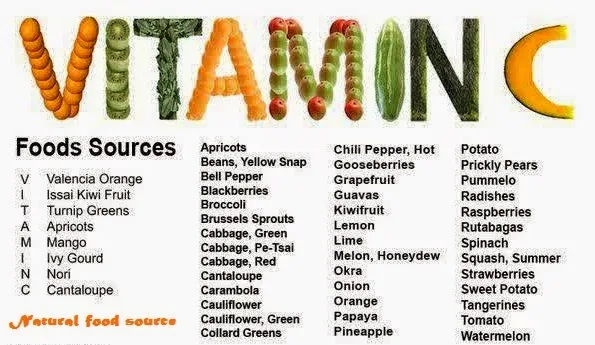Determine the content of vitamin C levels or at a natural food source is carried out in a laboratory test. Where people who do it usually because it has entered the realm of higher education. So that the test results are not uncommon levels of vitamin C may differ between laboratories with each other. Fruits and vegetables that contain vitamin C are green peppers, red peppers, guava, kiwi, broccoli, lychee, papaya, strawberries, oranges, cabbage, lemon, cantaloupe, cauliflower, garlic, grapefruit, tangerines, mandarin oranges , passion fruit, spinach, mango, potato, tomato, pineapple, grapes, watermelon, banana, avocado. There was also a source of food such as chicken liver (fried), fresh cow's milk, and sheep brain (boiled). But how is the content or the content can be obtained? Will be discussed later.
Determination of Different Levels of Vitamin C Natural Food Source
Since it is usually done in the Lab. The steps are as follows. This step is a common step in which not all fruits can be used step in vitamin C assay. So it needs no laboratory test many times to get the proper vitamin C levels. First take the pieces that you want to assign its vitamin C content. For example guava fruit. The fruit should have a weight of 100 grams (normal test dose for vitamins). Then squeezed juice with gauze. Then put in 100 milliliter flask. Then calibrated using distilled water and shaken average. A total of 15 milliliters of solution was taken and placed in 100 ml Erlenmeyer flask and add 25 milliliters of I (0.1 N); 5 milliliters of H2SO4 (2 N) after it was titrated with 0.1 Nagsgog. Up to young yellowish color. This process is called the process of determining the levels of vitamin C by titrimetry. That is not a direct titration.
Added 2 drops of starch by 5% and then continued until a deep blue color disappeared. Literacy is done in the triple. This procedure is done also for the blank, ie without guava juice. The amount of vitamin C is determined through calculations that every mole of moles of I2 would be oxidize ascorbic acid in a reaction redoks.Banyaknya I (z) which can react with ascorbic acid, calculated from the difference between the blank titration used to test samples of guava juice. So in get the vitamin C content in guava fruit is 228.3 milligrams per 100 grams of guava.
According to the results of research on the determination of vitamin C for a variety of natural food sources for each dose of 100 grams as follows. Levels of vitamin C in tomatoes 34 milligrams. Levels of vitamin C in oranges 50 mg. Levels of vitamin C in peppers 144-244 milligrams (depending on the type cabenya). Then the levels of vitamin C in 100 grams of other food sources kiwi 90 milligrams of vitamin C, 60 milligrams of vitamin C. papaya, strawberries 60 milligrams of vitamin C, 40 milligrams of vitamin C melon, grapefruit 30 milligrams of vitamin C, 30 milligrams tangerine vitamin C, oranges mandarin 30 milligrams of vitamin C, 30 milligrams of vitamin C passion fruit, pineapple 10 milligrams of vitamin C, and many others.
Benefits of Vitamin C for the Body
Vitamin C can also reduce levels of histamine in the body. So that the body is protected from toxins histamine. Another benefit in today's modern medical is able to whiten the skin. Because combined with collagen, vitamin C is injected into the body through the blood vessels. So that the skin will look whiter after some usage of vitamin C. Then vitamin C can certainly reduce or prevent canker sores, chapped lips, to reduce flu symptoms. There are many benefits of vitamin C that you can get which is also being investigated by researchers.
Vitamin C requirement for the Body
The need for the body of vitamin C on a daily basis between people with each other is different. Due to the factors of age, gender, amount of activity per day, and others. If generalized that the body needs vitamin C is 90 milligrams and should not be more than 2000 milligrams a day. Even so, there remains a difference between the researchers in this case. For example, there are menakarkan levels of vitamin C in the body is a minimum of 40 milligrams.
Keep your most important vitamin C is rather than not at all. Either naturally, or supplements. Because vitamin C can be a health therapy every day. With the right dose. Not deficiency and excess.
Related Post:
- Vitamin C Laroscorbine
- Due to Excess Vitamin C
- Due to Vitamin C Deficiency










0 comments:
Post a Comment